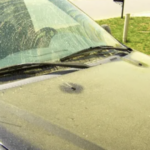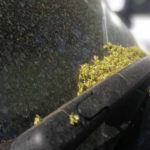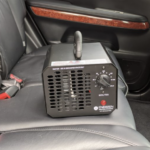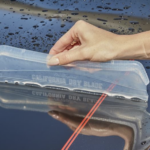Why Ozone Treatment Alone Might Not Be Enough to Get Rid of Cigarette Smoke Odor
Cigarette smoke is one of the toughest odors to remove from a car. It clings to upholstery, seeps into air vents, and embeds itself in carpets and headliners. Many people turn to ozone treatment as a solution, but is it enough on its own? The short answer: No.
While ozone generators can help neutralize lingering smoke smells, they don’t physically remove the tar and residue that cause the odor. For long-lasting results, you need to combine ozone treatment with deep cleaning techniques. This article explains why ozone alone isn’t enough and how to achieve true cigarette smoke removal.
What Is Ozone Treatment and How Does It Work?
Ozone (O₃) is a molecule made of three oxygen atoms. Unlike the oxygen we breathe (O₂), ozone is highly reactive. This reactivity allows it to break apart odor molecules and neutralize airborne contaminants.
How Ozone Treatment Works for Odor Removal
- An ozone generator releases O₃ into the air.
- Ozone molecules bind with smoke particles and break them down.
- Odors are neutralized at a molecular level.
- O₃ eventually reverts back to O₂, leaving cleaner air.
Ozone is effective at eliminating odors from the air, vents, and porous surfaces. However, it does not remove the physical residue that smoke leaves behind. That’s why relying on ozone alone won’t completely eliminate cigarette smoke odor.
The Limitations of Ozone Treatment for Cigarette Smoke
While ozone treatment helps, it has several limitations that make deep cleaning essential for full smoke removal.
1. Ozone Doesn’t Remove Tar and Residue
Cigarette smoke contains tar, nicotine, and other sticky residues that settle on every surface inside a car. These residues trap odors and continue releasing smoke smells over time.
- Where residue accumulates:
- Dashboard and door panels
- Seats, carpets, and headliner
- Air vents and HVAC system
- Windows and interior plastics
Ozone can neutralize airborne odors, but it doesn’t physically remove these residues. Without deep cleaning, smoke smells will eventually return.
2. Ozone Cannot Penetrate Deep into Upholstery and Carpets
While ozone can reach many areas in a car, it struggles to penetrate deep into fabric fibers and foam padding. Smoke particles seep deep into:
- Seats and cushions
- Carpet padding
- Headliner material
Since ozone primarily reacts with surface-level odors, deep-seated smoke smells can persist. This is especially true for older vehicles that have been exposed to cigarette smoke for years.
3. Ozone Takes Time to Work – and Can Be Dangerous
Ozone treatment isn’t instant. It usually requires several hours to work effectively. Even then, multiple treatments may be necessary.
Additionally, high levels of ozone can be harmful to humans and pets. It’s important to air out the car for several hours after treatment to avoid breathing in excess ozone.
4. Ozone Doesn’t Clean Air Filters and HVAC Systems
Cigarette smoke doesn’t just affect the visible surfaces in your car. It also gets trapped in the HVAC system, especially in the:
- Cabin air filter
- AC evaporator
- Ventilation ducts
Ozone treatment can circulate through the vents, but it won’t remove the tar and ash buildup inside the system. Without cleaning or replacing the cabin air filter, smoke odors can return every time you turn on the air conditioning.
The Best Way to Remove Cigarette Smoke: Combining Ozone with Deep Cleaning
To completely remove cigarette smoke from a car, ozone treatment must be paired with deep cleaning. Here’s a step-by-step approach for long-lasting odor removal.
Step 1: Remove All Loose Debris and Ash
Before using any treatments, remove all visible ash and debris:
✅ Vacuum seats, carpets, and under seats.
✅ Wipe down cup holders and door panels.
✅ Clean out vents using compressed air.
Step 2: Deep Clean Upholstery, Carpets, and Headliner
Since smoke penetrates fabrics, deep cleaning is essential.
✅ Deep Scrubbing: A thorough deep scrubbing of all carpet and upholstery including the headliner is essential.
✅ Enzyme Cleaners: These break down smoke molecules at a chemical level.
Step 3: Clean Hard Surfaces and Windows
Smoke leaves an invisible film on hard surfaces.
✅ Use an all-purpose cleaner or degreaser to wipe down dashboards, door panels, and plastics.
✅ Clean windows with ammonia-free glass cleaner to remove smoke residue.
Step 4: Replace the Cabin Air Filter and Clean the HVAC System
The cabin air filter traps smoke particles and must be replaced.
✅ Install a new activated charcoal cabin filter to absorb odors.
✅ Use AC evaporator cleaner to remove smoke buildup from the HVAC system.
Step 5: Apply Ozone Treatment for Final Odor Neutralization
After deep cleaning, ozone treatment is highly effective for eliminating any remaining airborne odors.
✅ Run the ozone generator for an hour or longer inside the car.
✅ Let the car air out for several hours before driving.
Does Ozone Treatment Have Any Benefits?
Despite its limitations, ozone treatment is still useful when combined with deep cleaning. It’s particularly effective for:
- Neutralizing airborne odors that are difficult to reach.
- Sanitizing bacteria and mold that can form in a smoke-filled car.
- Eliminating lingering odors after physical smoke residue is removed.
However, ozone should never be the only solution. Without deep cleaning, smoke odors will always return.
Why Deep Cleaning and Ozone Work Best Together
If you’re trying to completely remove cigarette smoke odor from a car, relying on ozone treatment alone isn’t enough. Ozone can neutralize airborne odors, but it doesn’t remove the sticky tar and nicotine residue left behind by smoke.
The best approach is to combine ozone treatment with deep cleaning:
✅ Deep clean upholstery and carpets to remove embedded smoke.
✅ Use enzyme cleaners to break down tar and nicotine.
✅ Wipe down hard surfaces to remove invisible residue.
✅ Replace the cabin air filter and clean the HVAC system.
✅ Finish with ozone treatment to neutralize any remaining odors.
By following these steps, you can eliminate cigarette smoke odors for good and restore your car’s fresh, clean scent. 🚗✨
Leave a Comment Cancel Comment
Book Orlando Mobile Detailing
Search
Latest Post
-
 The Cost of Neglect: Why Regular Aircraft Detailing Saves Money in the Long Run
February 14, 2025
The Cost of Neglect: Why Regular Aircraft Detailing Saves Money in the Long Run
February 14, 2025
-
 Why Car Washes Aren’t Enough to Combat Pollen Damage
February 13, 2025
Why Car Washes Aren’t Enough to Combat Pollen Damage
February 13, 2025
-
 Orlando’s Pollen Problem: When Is It the Worst and How It Affects Your Car
February 13, 2025
Orlando’s Pollen Problem: When Is It the Worst and How It Affects Your Car
February 13, 2025
-
 How Ozone Generators Eliminate Stubborn Car Odors in Orlando
February 12, 2025
How Ozone Generators Eliminate Stubborn Car Odors in Orlando
February 12, 2025
-
 Why a Water Blade and Chamois Beat Towels Every Time!
February 9, 2025
Why a Water Blade and Chamois Beat Towels Every Time!
February 9, 2025
